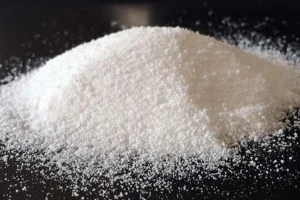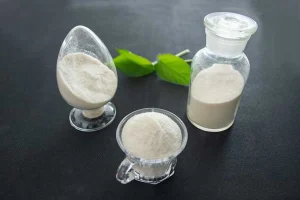Introduction of Sodium Gluconate

Sodium gluconate (E576), chemically known as C6H11NaO7, is a prominent food-grade additive derived from gluconic acid. Sodium gluconate is extensively used in the food industry as a preservative, stabilizer, and chelating agent.
The compound’s ability to bind with metals and minerals makes it an essential ingredient in various food processing applications. This introduction will explore the fundamental aspects of sodium gluconate, underscoring its critical contributions to food safety and quality enhancement.
By delving into its chemical identity and its pivotal functions, we set the stage for a detailed discussion on its expansive use across food products, ensuring that food items remain safe, palatable, and nutritionally valuable.
Chemical Properties
Sodium gluconate, with its chemical formula C6H11NaO7, exhibits unique characteristics that make it valuable in the food industry. This section outlines its fundamental physical and chemical attributes, stability, and reactivity, which are crucial for its applications.
Chemical Formula and Structure
Sodium gluconate is the sodium salt derivative of gluconic acid. Sodium gluconate usually appears as a granular to fine crystalline powder, ranging in color from white to tan. It dissolves easily in water, creating a clear and colorless solution.
Key Physical and Chemical Characteristics
The compound is non-toxic, biodegradable, and has excellent chelating properties, making it effective at binding calcium, iron, and other metals which can be beneficial in preventing oxidation and spoilage in food products.
Stability and Reactivity Under Various Conditions
Sodium gluconate is stable under ordinary conditions of use and storage. It does not decompose under high temperatures used in food processing and is non-reactive with other food ingredients. Its stability in acidic and alkaline environments also contributes to its versatility as a food additive.
Production Process
The industrial production of sodium gluconate involves several key steps, utilizing specific raw materials and incorporating modern technological advancements to enhance efficiency and output. This segment outlines the production process, highlighting how sodium gluconate is manufactured.
Description of How Sodium Gluconate is Produced Industrially
Sodium gluconate is typically produced via the fermentation of glucose. In this process, a particular strain of bacteria is employed to transform glucose into gluconic acid. This acid is subsequently neutralized using sodium hydroxide to create sodium gluconate. This technique is favored for its high efficiency and the exceptional quality of the product it yields.
Key Raw Materials Used in the Production
The primary raw material for producing sodium gluconate is glucose, which can be derived from various starch-rich sources like corn, rice, or wheat. The process also requires sodium hydroxide for neutralization and specific microbes for the fermentation stage.
Innovations in Production Technology
Recent innovations in the production of sodium gluconate focus on improving the fermentation yields and reducing energy consumption. Techniques such as continuous fermentation, the use of genetically modified organisms for higher efficiency, and optimization of the microbial environment are significant advancements that have improved the sustainability and cost-effectiveness of production.
Applications in the Food Industry

Sodium gluconate is a versatile additive in the food industry, utilized for its excellent chelating and stabilizing properties. This section discusses its broad range of applications, detailing how it enhances food products’ safety, shelf-life, and quality.
As a Food Additive: Purposes and Benefits
E576 is primarily used as a sequestrant, a substance that binds and removes metal ions, which can catalyze oxidative spoilage in food products. It helps to improve the texture and stability of foods, prevents discoloration, and extends shelf life, making it invaluable in packaged and canned foods.
Specific Uses in Different Food Products
In dairy products, sodium gluconate prevents milk proteins from precipitating and keeps essential minerals soluble, enhancing the smoothness of dairy desserts and creams. In baked goods, it regulates the pH level and acts as a leavening agent. In meat processing, it helps in curing and seasoning by stabilizing color and flavor.
Regulatory Status and Typical Concentrations Used
Major health authorities, such as the FDA and EFSA, deem sodium gluconate as safe for use. It is used in concentrations typically ranging from 0.1% to 0.3% by weight of the final product, depending on the specific application and local regulatory guidelines.
Health and Safety Considerations

Sodium gluconate is extensively utilized in the food industry and is known for its established safety profile. This section explores potential health impacts, dietary considerations, and regulatory guidelines surrounding its use.
Safety Profile of Sodium Gluconate
Significant health organizations, such as the U.S. Food and Drug Administration (FDA), generally regard sodium gluconate as safe (GRAS). It is non-toxic and has a low potential for causing adverse health effects when used as directed in food applications.
Potential Side Effects and Dietary Concerns
While sodium gluconate is safe for the general population, excessive intake can lead to minor gastrointestinal disturbances such as nausea or diarrhea in sensitive individuals. It is crucial to follow recommended usage guidelines to prevent such side effects.
Regulatory Guidelines and Acceptable Daily Intake Levels
Regulatory authorities such as the FDA in the United States and the European Food Safety Authority (EFSA) in Europe have implemented regulations that dictate the use of sodium gluconate in various food items. The acceptable daily intake (ADI) is not specified because of its low toxicity, but usage levels are typically controlled within the bounds of good manufacturing practices (GMP).
Environmental Impact
Sodium gluconate is not only beneficial in food applications but also carries an environmentally friendly profile. This section assesses biodegradability, environmental concerns during production and disposal, and potential measures to reduce environmental footprint.
Biodegradability of Sodium Gluconate
Sodium gluconate is highly biodegradable, breaking down into water and carbon dioxide when exposed to biological processes in the environment. This characteristic helps reduce its long-term effects on ecosystems, positioning it as a favored option in environmentally aware food processing methods.
Environmental Considerations in Its Production and Disposal
The production of sodium gluconate involves resource-intensive processes, including the consumption of large amounts of water and energy. Effluents from manufacturing facilities must be properly treated to prevent pollution. Similarly, disposal practices for waste sodium gluconate should adhere to environmental regulations to ensure that it does not adversely affect the local environment.
Ways to Mitigate Environmental Impact
Manufacturers can adopt greener technologies and recycling strategies to minimize the environmental footprint of sodium gluconate production. Energy-efficient methods, the use of renewable energy sources, and the recycling of waste products within the production cycle are effective strategies for reducing environmental impact.
Market Analysis
Sodium gluconate has significant commercial value in the global market due to its widespread use in food and other industries. This section offers an overview of current market trends, major market participants, and projections for the future.
Global Demand and Supply Trends
The demand for sodium gluconate has been steadily increasing, driven by its diverse applications in food preservation, pharmaceuticals, and as a cleaning agent in industrial settings. Supply has kept pace with demand, facilitated by advancements in production technologies and the scaling up of operations by major manufacturers.
Key Players in the Sodium Gluconate Market
The market is dominated by a few large chemical companies that have extensive distribution networks and advanced production capabilities. These companies invest heavily in research and development to improve production efficiency and product quality, which helps them maintain a competitive edge.
Future Outlook and Growth Potential
The future of the sodium gluconate market looks promising with expected growth in the food industry and emerging markets. The increasing emphasis on food safety and shelf-life extension, coupled with the rise in consumer preference for natural preservatives, is likely to fuel further growth. Advancements in biotechnology and sustainable practices may also pave the way for new uses and heightened demand.
Conclusion
This final section summarizes the critical roles and future potential of sodium gluconate in the food industry, encapsulating the insights gathered throughout the article.
Summary of the Importance and Versatility of Sodium Gluconate in the Food Industry
Sodium gluconate is a key food additive, valued for its ability to improve food safety, enhance quality, and extend shelf life. Its diverse applications and safety profile underscore its significance within the food processing sector.
Future Research Directions or Anticipated Developments in Its Use
Future research could focus on optimizing sodium gluconate’s production process to enhance its environmental friendliness and cost-effectiveness. Additionally, exploring new applications in food and other industries may further expand its usage and market reach.
We provide high-quality food-grade sodium gluconate produced in India and can be shipped immediately. The comprehensive sodium gluconate wholesale solutions making NIRAN Biochemical is your first choice.
